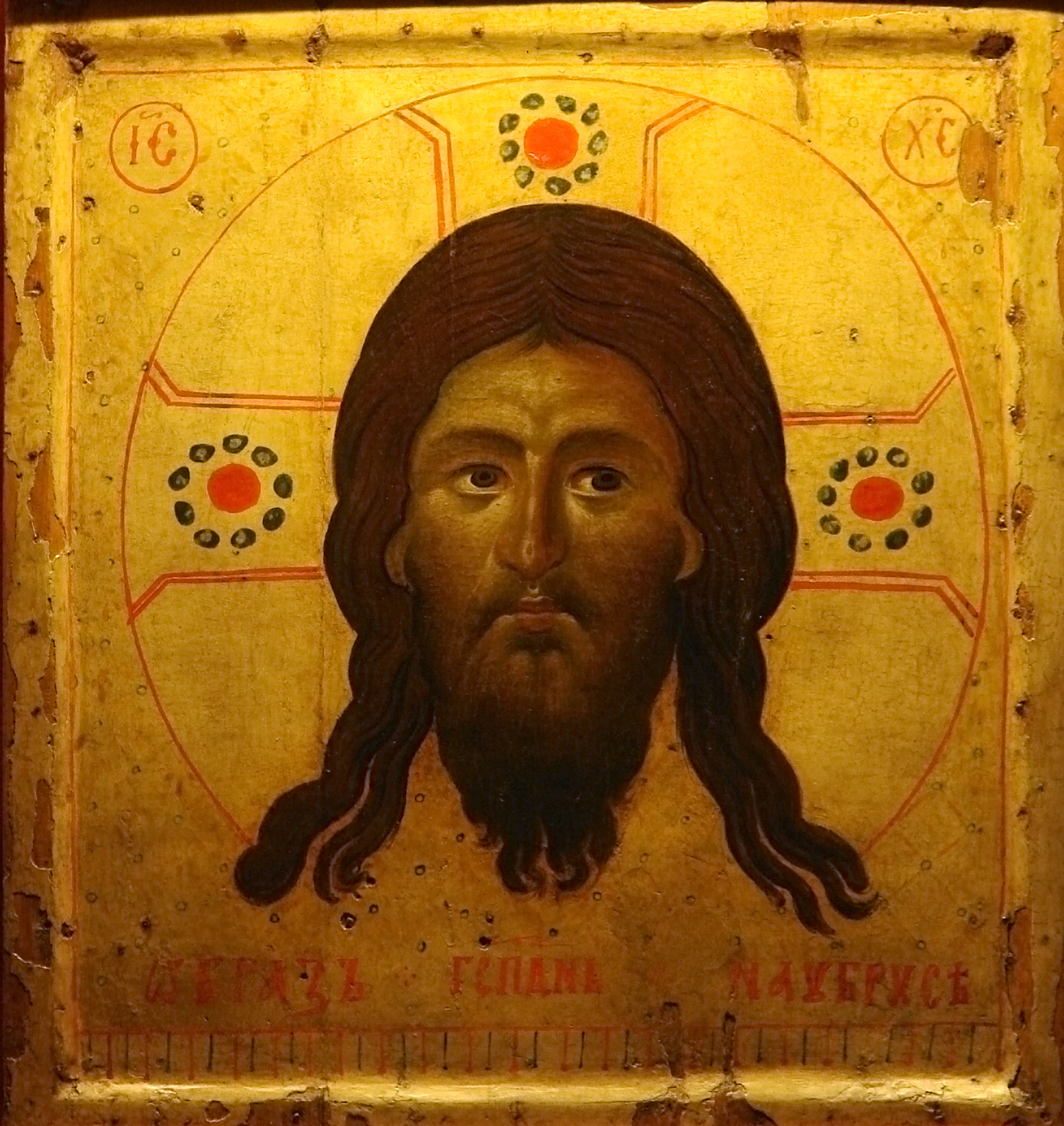Continuing from part "#2 The Vignon markings (4)" with this part #2 (5) of my series "Four proofs that the AD 1260-1390 radiocarbon date for the Shroud has to be wrong!"
Examples of 6th to 12th century artistic representations of Christ's face which bear the Vignon markings found on the Shroud, include:
Holy Face of Laon (12th century)

[Above (click to enlarge): The Holy Face of Laon: Wikipedia. "Icon of the Holy Face (Mandylion), purchased in 1249 in Bari (Italy) by Jacques Pantaleon, archdeacon of the cathedral of Laon, who later became Pope Urban IV. Exhibited in the Cathedral of Laon." (Wikipedia, Google translated from French).]
The "Holy Face of Laon" (Fr. Sainte Face de Laon) [1] is about 44 cm high and 40 cm wide, and bears an image of Christ's face painted on wood. [2] It has an inscription in Old Slavonic, by the artist, which reads, "Obraz Gospodin na Ubruzje" ("The Lord's picture on the Cloth"). [1]
In 1249 papal chaplain Jacques Pantaleon de Troyes (later Pope Urban IV) sent this icon from Rome to his sister Sibylle, Abbess of the French Cistercian convent of Montreuil-des-Dames. [3] In 1795 the painting was transferred to Laon Cathedral where it has been ever since. [2]
Therefore this icon must have been painted many years, if not decades, before 1249, and if it was copied from the Shroud, then that must have been in existence even earlier still. [4] It is probable that this icon was already ancient when Jacques de Troyes received it as a gift from the Serbian Orthodox church, which had been liberated from the Byzantine Emperor's authority after the sack of Constantinople in 1204. [2] The most likely time of the icon's creation is between 944 and 1201, when the Shroud was in Constantinople. [3] And since it preserves features associated with the Edessa Cloth or Mandylion [5], such as the face of Christ surrounded by a circular "halo," which was in turn surrounded by a gold trellis pattern [6], a tenth century origin seems more likely, before it was discovered in Constantinople that the Mandylion head cloth was actually the full-length Shroud. [7] So if the Holy Face of Laon is a copy of the Shroud, then the 1988 radiocarbon dating of the Shroud as "medieval ... AD 1260-1390" [8] must be wrong! [4]
The fifteen Vignon markings [see part #2 (1)], including "a transverse streak across the forehead, a three-sided `square' between the brows, a V-shape at the bridge of the nose, a raised right eyebrow, accentuated left cheek, enlarged left nostril, a hairless area between the lower lip and the beard and two strands of hair descending from the middle parting" [4], found on the Shroud and on many Byzantine depictions of Christ from the 6th to 12th centuries, is proof beyond reasonable doubt that these early artists were working from the Shroud. [4] And the Laon icon contains more Vignon markings than any other known icon [9], thirteen of the fifteen [4] Indeed, by my count it it has fourteen out of the fifteen :
"(1) Transverse streak across forehead, (2) three-sided `square' between brows, (3) V shape at bridge of nose, (4) second V within marking 2, (5) raised right eyebrow, (6) accentuated left cheek, (7) accentuated right cheek, (8) enlarged left nostril, (9) accentuated line between nose and upper lip, (10) heavy line under lower lip, (11) hairless area between lower lip and beard, (12) forked beard, ... (14) heavily accentuated owlish eyes, (15) two strands of hair." [10]and of the one that is missing, "(13) transverse line across throat," there is no throat area shown on the icon! Moreover, the Holy Face of Laon is particularly notable for the minute exactness with which it reproduces some of these anomalies of the Shroud, an exactness which would only have been possible if the artist had the Shroud before his eyes. [11] This, together with the artist's inscription that his painting was of "The Lord's picture on the Cloth", must mean that he was working directly from the Shroud itself. [9]
But, as we have seen, the Holy Face of Laon was already ancient in 1249, which itself is over a decade before the earliest possible radiocarbon date of 1260. Therefore, once again, the 1988 radiocarbon dating of the Shroud as "medieval ... AD 1260-1390" [8] has to be wrong!
[To be continued]
Hagia Sophia narthex mosaic (10th century)
Sant'Angelo in Formis fresco (11th century)
Pantocrator of St Saviour in Chora, in Istanbul (11th century)
Daphni Pantocrator (11th century)
Cefalù apse mosaic (12th century)
References
[1] Currer-Briggs, N., 1988, "The Shroud and the Grail: A Modern Quest for the True Grail," St. Martin's Press: New York NY, p.58. [return]
[2] de Riedmatten, P., "The Holy Face of Laon," British Society for the Turin Shroud Newsletter, No. 68, December 2008. [return]
[3] Wilson, I., 1991, "Holy Faces, Secret Places: The Quest for Jesus' True Likeness," Doubleday: London, pp.47,79. [return]
[4] Currer-Briggs, N., 1995, "Shroud Mafia: The Creation of a Relic?," Book Guild: Sussex UK, pp.56-57. [return]
[5] Wilson, I., 1998, "The Blood and the Shroud: New Evidence that the World's Most Sacred Relic is Real," Simon & Schuster: New York NY, pp.150-151. [return]
[6] Wilson, I., 1979, "The Shroud of Turin: The Burial Cloth of Jesus Christ?," Image Books: New York NY, pp.114-115, 121. [return]
[7] Wilson, 1979, pp.157-158. [return]
[8] Damon, P.E., et al., 1989, "Radiocarbon Dating of the Shroud of Turin," Nature, Vol. 337, 16 February, pp.611-615, p.611. [return]
[9] Currer-Briggs, 1988, pp.67-68. [return]
[10] Wilson, I., 1978, "The Turin Shroud," Book Club Associates: London, p.82e. [return]
[11] Wuenschel, E.A., 1954, "Self-Portrait of Christ: The Holy Shroud of Turin," Holy Shroud Guild: Esopus NY, Third printing, 1961, pp.58-59. [return]
Posted: 23 April 2012. Updated. 22 December 2017.




No comments:
Post a Comment